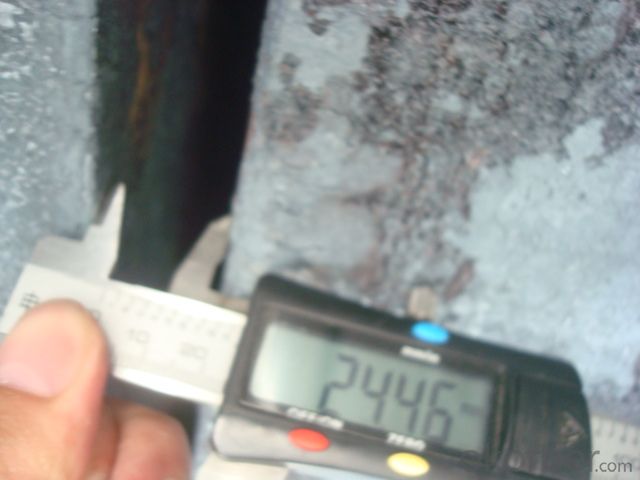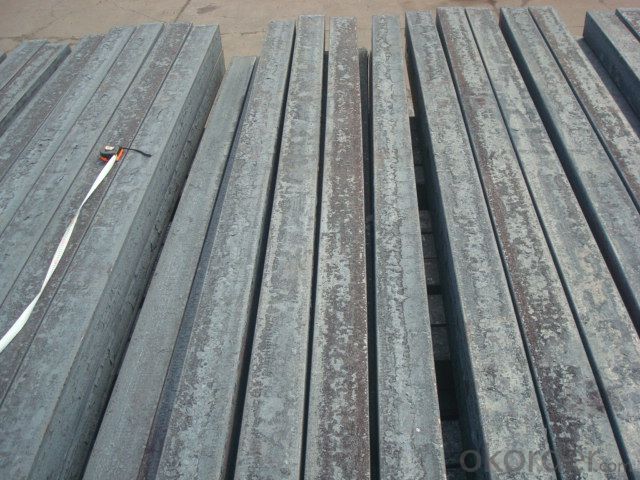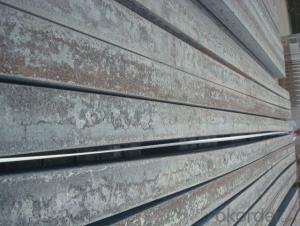Alloyed Continue Casting Steel Billet by Blast Furnace
- Loading Port:
- Tianjin
- Payment Terms:
- TT OR LC
- Min Order Qty:
- 1000 m.t.
- Supply Capability:
- 10000 m.t./month
OKorder Service Pledge
OKorder Financial Service
You Might Also Like
Alloyed Continue Casting Steel Billet by Blast Furnace
1.Structure of Alloyed Continue Casting Steel Billet by Blast Furnace
Steel Blooms Manufactured by Continue Casting is the raw material of all kinds of steel mill. Bloom section of square, round, flat, rectangular and abnormity, etc Several, mainly related to shape of rolled products. Simple rolled section steel, choose cross section of square Bloom or rectangular Bloom. rolling The sector products such as flat steel, Angle steel, select the rectangular Bloom or slab. Had better profiled Bloom when production beams, channels, and in rolling process Lines and improve the yield. The raw material of round Bloom is the production of seamless tube.
2.Main Features of Alloyed Continue Casting Steel Billet by Blast Furnace.
Steel Blooms Manufactured by Continue Casting section size should meet the requirements of rolling deformation and finished product quality, but also roll strength and biting condition of restrictions. General steel Bloom section height H. And the roll diameter D The ratio of the ( namely H/D) Should be less than or equal to zero 0.5 . Length of steel Bloom by finishing temperature, Rolling time and the length of the product Or times ruler. When heated too long accident prone to bump the furnace wall of steel, too short, furnace bottom utilization rate is not high, influence the heating furnace production. For the production Choose a variety of steel and steel Bloom, should consider the affinities of Bloom, as far as possible in order to improve the productivity of the roughing mill, simplify the stock management of workshop.
There are three shapes of the steel Blooms: square Bloom, slab, rectangular Bloom The Chinese Bloom, rectangular Bloom is mainly suitable for rolling hot rolled strip, building reinforced bar, Ordinary wire, high speed wire rod and various small profile. Of the slab are mainly used for rolling plate and hot coil sheet.
3. Alloyed Continue Casting Steel Billet by Blast Furnace Images


4. Alloyed Continue Casting Steel Billet by Blast Furnace Specification
Alloyed Continue Casting Steel Billet by Blast Furnace rolled steel, after processing can be used for mechanical parts, forging parts, processing all kinds of steel, steel Q345B channel steel, wire rod is the role of the Bloom. Steel Bloom is used in the production of semi-finished products, generally cannot be used directly for the society. Steel Blooms and steel are strictly divided into standard, cannot decide to whether the business enterprise of the final product, and according to unified standards to perform the whole society. Typically, Bloom and the steel is relatively easy to distinguish, but for some steel Bloom, and have the same specification and same steel purposes (such as rolling tube Bloom), whether can be used for other industries, whether through steel processing process, whether through a finished product rolling mill processing to distinguish
Material standard The editor Range of thickness: 150-240 - mm + / - 5 mm width range: 880-1530 - mm + / - 20 mm Length: 3700-10000 - mm + / - 500 - mm Cross-sectional size: 64 * 64; 82 * 82; 98 * 98; 124 * 124; 120 * 150; 152 * 164; 152 * 170 mm Length: 9000 mm Section of tolerance: Bloom: 1.0 + / - 2.0-1.0 + / - 1.0 mm slab: width: + / - 2.0 mm thickness: + / - 3.0 mm The length tolerance: + / - 200 mm Section diagonal tolerance: 3.5-8.0 MM Bloom section size protrusions requirements: < 1242 mm, do not allow; > = 1242 mm, < = 2 mm 1242 mm, < = 3 mm Beheading (shear) extension deformation: < 1242 mm Bloom: no control; The slab: < = 15 mm Surface tilt: no more than Bloom section 0.1 Bending: every 1 m length is not more than 10 mm The distortion: length < = 5 m, < = 11. ; The length of the < = 7.5 M, < = 5. Material % 3 sp/PS chemical composition: C Mn Si S P
5.FAQ of Alloyed Continue Casting Steel Billet by Blast Furnace
We have organized several common questions for our clients,may help you sincerely:
①How about your company?
A world class manufacturer & supplier of castings forging in carbon steel and alloy steel,is one of the large-scale professional investment casting production bases in China,consisting of both casting foundry forging and machining factory. Annually more than 8000 tons Precision casting and forging parts are exported to markets in Europe,America and Japan. OEM casting and forging service available according to customer’s requirements.
②How to guarantee the quality of the products?
We have established the international advanced quality management system,every link from raw material to final product we have strict quality test;We resolutely put an end to unqualified products flowing into the market. At the same time, we will provide necessary follow-up service assurance.
③Could arrange the inspection before shipping?
Yes, you can. And you can arrange like the SGS, INTERTECH third party inspecting company to check for you before shipping.
- Q:How are steel billets classified based on their chemical composition?
- Steel billets can be classified based on their chemical composition using different grading systems. One common classification method is based on the carbon content of the billets. This method categorizes steel billets into three main groups: low carbon steel billets, medium carbon steel billets, and high carbon steel billets. Low carbon steel billets typically have a carbon content of less than 0.25%. These billets are known for their excellent ductility and weldability. They are commonly used in applications that require good formability and low strength, such as construction materials and automotive components. Medium carbon steel billets usually have a carbon content ranging from 0.25% to 0.60%. These billets have improved strength and hardness compared to low carbon steel billets. They are commonly used in applications that require higher strength, such as machinery parts, shafts, and gears. High carbon steel billets have a carbon content greater than 0.60%. These billets are known for their exceptional strength and hardness. They are commonly used in applications that require high wear resistance, such as cutting tools, springs, and knives. Apart from the carbon content, other chemical elements present in the steel billets can also affect their classification. For example, the presence of alloying elements like chromium, nickel, and molybdenum can enhance the properties of the steel, such as corrosion resistance or heat resistance. Steel billets can be further classified based on the specific alloying elements present and their concentrations. Overall, the classification of steel billets based on their chemical composition allows for better understanding and selection of the appropriate material for specific applications, ensuring the desired properties and performance of the final product.
- Q:What are the different types of steel billet cutting processes?
- There are several different types of steel billet cutting processes used in various industries. Some of the most common types include: 1. Shearing: This process involves using a shear machine to cut the steel billet into the desired shape. Shearing is typically used for cutting straight lines and is a cost-effective method for smaller billets. 2. Sawing: Sawing is another popular method for cutting steel billets. It involves using a circular or band saw to cut through the billet. Sawing is suitable for cutting both straight and curved lines, making it more versatile than shearing. 3. Flame cutting: Flame cutting, also known as oxy-fuel cutting, uses a combination of oxygen and a fuel gas (such as acetylene) to heat the steel to its ignition temperature. A high-pressure stream of oxygen is then directed onto the heated area, causing the steel to oxidize and melt away. This process is commonly used for cutting thicker steel billets. 4. Plasma cutting: Plasma cutting involves using a plasma torch to cut through the steel billet. The torch generates a high-temperature plasma arc that melts the metal, while a high-velocity gas stream blows away the molten metal. Plasma cutting is often used for cutting through thick steel billets or for creating intricate shapes. 5. Waterjet cutting: Waterjet cutting utilizes a high-pressure jet of water mixed with an abrasive material (such as garnet) to cut through the steel billet. The abrasive particles in the waterjet help erode the steel, allowing for precise and clean cuts. Waterjet cutting is commonly used for cutting complex shapes or materials that are sensitive to heat. These are just a few of the different types of steel billet cutting processes available. The choice of method depends on factors such as the size of the billet, desired shape, precision requirements, and the budget available.
- Q:What is the composition of steel billets?
- Steel billets are primarily composed of iron, with varying amounts of carbon and other alloying elements such as manganese, silicon, and chromium. The exact composition depends on the specific grade and intended use of the steel billet.
- Q:How do steel billets contribute to the energy sector?
- Steel billets contribute to the energy sector by being used in the construction of various infrastructure projects, such as power plants, transmission towers, and pipelines. These steel billets provide the necessary strength and durability required for these structures to withstand harsh environmental conditions and support the efficient generation, transmission, and distribution of energy.
- Q:How are steel billets used in the production of valves and fittings?
- Steel billets are used in the production of valves and fittings as raw material. They are heated, shaped, and machined to form the desired components, ensuring strength, durability, and precision.
- Q:What are the main differences between hot rolled and cold rolled steel billets?
- The main differences between hot rolled and cold rolled steel billets lie in the manufacturing process and the resulting properties of the finished product. Hot rolled steel billets are produced by heating the steel to a high temperature and then rolling it through large rollers. This process allows for the steel to be shaped and formed easily, resulting in a product with a rougher surface and less precise dimensions. Hot rolled steel billets also tend to have a scaled surface due to the high temperature involved in the manufacturing process. On the other hand, cold rolled steel billets are produced by cooling the steel to room temperature and then passing it through rollers at a lower temperature. This process not only results in a smoother surface finish but also allows for tighter tolerances and more precise dimensions. Cold rolled steel billets have a more uniform appearance and are often used in applications that require a higher degree of precision and accuracy. In terms of mechanical properties, hot rolled steel billets generally have a lower strength and hardness compared to cold rolled steel billets. Cold rolled steel billets also tend to have improved surface hardness and a higher degree of dimensional stability. Overall, the main differences between hot rolled and cold rolled steel billets are the manufacturing process, surface finish, dimensional accuracy, and mechanical properties. Hot rolled steel billets are more easily shaped and formed, while cold rolled steel billets have a smoother surface finish and more precise dimensions. The choice between the two depends on the specific requirements of the application.
- Q:How do steel billets contribute to the overall safety of a product?
- There are several ways in which steel billets contribute to the overall safety of a product. Firstly, the manufacturing process of steel billets is controlled to ensure a high level of quality and consistency in the material. This means that the steel produced from these billets will have consistent mechanical properties, such as strength and toughness, which are crucial for ensuring the safety of the final product. Furthermore, various testing and inspections are carried out on steel billets during the manufacturing process to ensure that they meet the required specifications and standards. This includes checks for surface defects, internal soundness, and proper chemical composition. By ensuring that the steel billets are defect-free and meet the necessary quality standards, the risk of failure or malfunction in the final product is significantly reduced. Moreover, steel billets are known for their exceptional strength and durability. Steel is a highly robust material that can withstand high temperatures, pressure, and impacts without deforming or breaking. This inherent strength makes steel billets particularly suitable for applications where safety is a priority, such as in the construction of buildings, bridges, and infrastructure. Additionally, steel billets can be easily shaped and formed into various components and structures, allowing for precise manufacturing and design. This versatility enables engineers and designers to create products with optimal safety features, such as reinforced beams or structures that can withstand extreme loads or impacts. The ability to customize steel billets to meet specific safety requirements ensures that the final product is tailored to address potential safety risks and hazards. Lastly, steel billets are highly resistant to corrosion, making them ideal for applications in harsh environments or exposure to corrosive substances. The resistance to corrosion ensures that the structural integrity of the product is maintained over time, reducing the likelihood of failures due to material degradation. In conclusion, steel billets contribute to the overall safety of a product by providing a high-quality, defect-free, strong, and durable material that can be customized to meet specific safety requirements. The controlled manufacturing process, rigorous testing, and inherent properties of steel make it an ideal choice for ensuring the safety and reliability of various products.
- Q:How do steel billets contribute to the manufacturing of packaging materials?
- Steel billets are an essential component in the manufacturing of packaging materials, especially those that require strength and durability. These billets, which are semi-finished steel products, are typically obtained through the process of continuous casting or hot rolling. One of the primary ways steel billets contribute to packaging material manufacturing is through their use in the production of steel drums. Steel drums are widely used in industries such as chemicals, petroleum, and food processing to store and transport various substances. The strength and rigidity of steel billets make them an ideal choice for manufacturing these drums, ensuring that they can withstand the weight and pressure of their contents without any compromise in the packaging's integrity. In addition to steel drums, steel billets are also crucial in the production of metal cans. Metal cans are widely used for packaging food, beverages, and other consumer products. They provide an excellent barrier against moisture, light, and oxygen, ensuring the preservation and safety of the packaged goods. Steel billets are used to create the can bodies, lids, and bottoms, providing the necessary strength and stability to withstand the pressure during the canning process and transportation. Moreover, steel billets are utilized in the manufacturing of steel straps and bands used for securing and bundling packages. These straps help to secure heavy and bulky items, preventing them from shifting or getting damaged during transit. The high tensile strength of steel billets ensures that the straps can adequately hold the packages together, providing stability and protection. Furthermore, steel billets are sometimes used in the production of corrugated steel sheets. These sheets are commonly used in the manufacturing of heavy-duty packaging materials such as crates and pallets. Corrugated steel sheets provide excellent strength and rigidity, making them suitable for transporting heavy items across long distances. Steel billets are transformed into these sheets through a series of processes such as rolling, cutting, and shaping, ensuring the final product meets the required specifications. In summary, steel billets play a crucial role in the manufacturing of packaging materials. Their strength, durability, and versatility make them ideal for producing steel drums, metal cans, straps, and corrugated steel sheets. By utilizing steel billets, manufacturers can create packaging materials that can withstand the demands of various industries, ensuring the safe and secure transportation of goods.
- Q:How do steel billets contribute to the overall safety of a structure?
- Steel billets contribute to the overall safety of a structure by providing a strong and durable material for construction. The high strength and toughness of steel billets make them resistant to external forces such as earthquakes, wind, and heavy loads. Additionally, steel billets have excellent fire resistance, as they do not burn or release toxic gases when exposed to high temperatures. This ensures the structural integrity of the building during a fire. Moreover, steel billets can be easily fabricated into various shapes and sizes, allowing for precise engineering and construction, which further enhances the safety and stability of the structure.
- Q:How to calculate the cost price of billet?
- The ratio of slag to billet (63% fine powder) is about 3:1, which accounts for about 60%. of billet cost
1. Manufacturer Overview |
|
|---|---|
| Location | |
| Year Established | |
| Annual Output Value | |
| Main Markets | |
| Company Certifications | |
2. Manufacturer Certificates |
|
|---|---|
| a) Certification Name | |
| Range | |
| Reference | |
| Validity Period | |
3. Manufacturer Capability |
|
|---|---|
| a)Trade Capacity | |
| Nearest Port | |
| Export Percentage | |
| No.of Employees in Trade Department | |
| Language Spoken: | |
| b)Factory Information | |
| Factory Size: | |
| No. of Production Lines | |
| Contract Manufacturing | |
| Product Price Range | |
Send your message to us
Alloyed Continue Casting Steel Billet by Blast Furnace
- Loading Port:
- Tianjin
- Payment Terms:
- TT OR LC
- Min Order Qty:
- 1000 m.t.
- Supply Capability:
- 10000 m.t./month
OKorder Service Pledge
OKorder Financial Service
Similar products
New products
Hot products
Related keywords





























